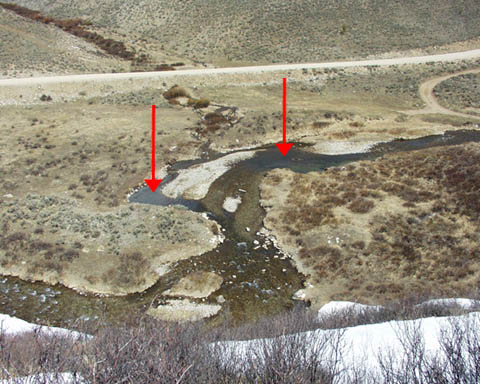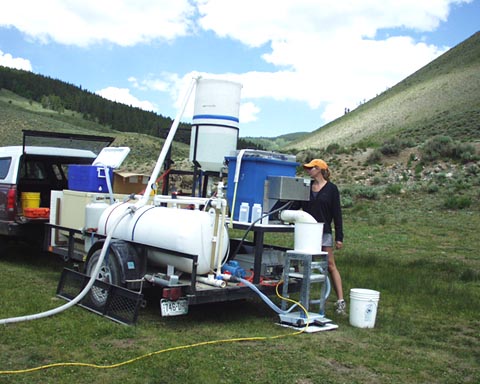Habitat manipulations and interactions
One approach to controlling the whirling disease parasite is to try to minimize habitats that are especially prone to harbor populations of the Tubifex worm that acts as the necessary alternate host of the parasite. Several capital construction projects in streams have been attempted to reduce or isolate such habitats (see slide 1 below). The last of five such projects was completed in November 2004, and monitoring of these habitat projects will continue for several years. Early indications are that isolating or removing significant, but isolated, patches of worm habitat will not always have the effect of reducing parasite activity in the entire area of the project. Sometimes, there appear to be enough small habitat areas that they cumulatively have the same effect as the large area that was removed or isolated. In at least one stream (Beaver Creek, South Fork Rio Grande, the first one completed, October 2001) such a small project appears to have benefited the stream. Fewer TAMs are observed there today, and for the last two years increased numbers of juvenile rainbow trout have been captured in annual population surveys.
Other research addresses the impacts that off-channel sites such as hatchery effluents and private ponds may have on stream fisheries. Because these off-channel pond habitats can be conducive to dense Tubifex populations, research has focused on two concepts: Minimizing the number of worm-infective spores that might be introduced to such ponds, and preventing TAMs produced in these ponds from reaching the stream.
For the first research concept, fish management plays a key role. At some hatchery sites, settling ponds are kept free of escaped fish, and this has had a positive effect in reducing the numbers of TAMs produced. At others we have conducted research on the number of catchable rainbow trout (unexposed to M. cerebralis) that can be safely stocked. Nearly all of the fish are removed by anglers during the fishing season, leaving few stocked fish at large that might subsequently develop high concentrations of spores. The overall objective at CPW hatchery settling ponds that will likely never be free of the parasite is to allow no higher a density of TAMs in pond effluents than is found in the receiving water.
At one off-channel site, a sand filter was constructed to determine whether this would be an effective way to trap TAMs (see slide 2 below). This filter has proven effective in removing TAMs, but it has lost much of its capacity in the two seasons it has been in use and no longer can handle the entire pond effluent. The backflush system that was installed has had only limited positive effect in restoring flow capacity.
Parasite monitoring
Researchers have used a technique called “flat screen” filtration since 1998 to monitor TAM densities in the wild. This method involved screening 500 gallons of water through a very small mesh and examining portions of the filtrate by microscope. Although it was invaluable in discerning seasonal patterns of parasite presence and describing rough trends over the years, it was also regarded as imprecise. In 2004, a filtration device incorporating “packed bed” technology was constructed, based on a unit previously built by researchers in Montana. Using a mere 30 gallons per sample, this device (see slide 3 below) has the ability to detect TAMs at lower densities than the flat screen method, but is also labor intensive and not portable to remote locations. A series of tests during 2004 revealed that using the same 30-gallon quantities in the flat screen technique could provide similar results as the packed bed technology (see slide 4 below). Filtrates are larger from the flat screen technique, so fewer TAMs are actually seen, which results in less precision in the point estimate, but has the advantage of being more portable, taking less time, and remaining operational in freezing weather. Currently, both methods are being used for monitoring, but the 500-gallon quantities are no longer used in the flat screen method.
Slides
Slide #1. Before (top) and after (bottom) photographs of a stream site modified to reduce the amount of Tubifex habitat. Sediment accumulations rich in organic material existed at the locations indicated by red arrows in the upper photograph.


Slide #2. This experimental sand filter was constructed on the effluent of a private pond to trap TAMs before they reached the waterway. Its effectiveness is good in terms of trapping the TAMs but its capacity has been reduced by about half since it was put in operation.

Slide #3. The packed bed filtration device, often referred to as the “tamometer”, deployed to collect field samples at Spring Creek, tributary to the Taylor River.

Slide #4. On average, TAM density point estimates are not statistically different between the packed bed and 30-gallon flat screen methods. This chart depicts the results of 16 trials (no TAMs were detected in trial 3). Three replicate samples were taken with each method for each trial except the first (4 replicates).


